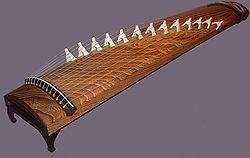
Back كوتو (آلة موسيقية) Arabic كوتو (اله موسيقيه) ARZ Koto Azerbaijani Кото Bulgarian Koto Breton Koto (instrument musical) Catalan Koto Czech Кото CV Koto Welsh Koto German
 | |
| String instrument | |
|---|---|
| Other names | 13-stringed koto |
| Classification | Stringed instrument |
| Hornbostel–Sachs classification | 312.22–6 (Heterochord half-tube zither sounded with three plectrums) |
| Inventor(s) | Kenjun |
| Developed | 16th century |
| Related instruments | |
The koto (箏 or 琴) is a Japanese plucked half-tube zither instrument, and the national instrument of Japan. It is derived from the Chinese zheng and se, and similar to the Mongolian yatga, the Korean gayageum and ajaeng, the Vietnamese đàn tranh, the Sundanese kacapi and the Kazakh jetigen.[1] Koto are roughly 180 centimetres (71 in) in length, and made from Paulownia wood (Paulownia tomentosa, known as kiri). The most common type uses 13 strings strung over movable bridges used for tuning, different pieces possibly requiring different tuning. Seventeen-string koto are also common, and act as bass in ensembles. Koto strings are generally plucked using three fingerpicks (tsume), worn on the first three fingers of the right hand.
- ^ "Koto". Encyclopædia Britannica. Retrieved 2008-03-18.[dead link]
